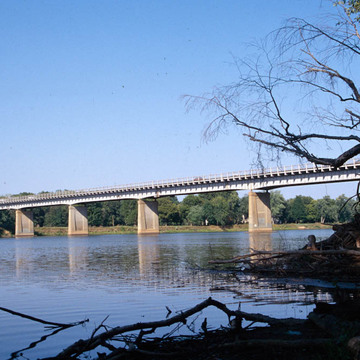An earlier metal truss bridge crossed the James River several hundred feet west of the present concrete and steel bridge. Old Bridge Lane, now a quiet suburban street, was the approach. The late 1940s replacement bridge has a delicate metal rail that allows views of the riverscape. Westham Station Road, which extends on the west side of the bridge, runs along one of the more intact sections of the Kanawha Canal. This is part of the first section completed between Richmond and the village of Westham. The Chesapeake and Ohio train tracks were laid in 1889 on the towpath, on the south side of the canal. George Washington's vision of a transportation route west was finally realized by rail, despite persistent efforts through the late 1870s to operate the canal.
You are here
Huguenot Bridge and Kanawha Canal
If SAH Archipedia has been useful to you, please consider supporting it.
SAH Archipedia tells the story of the United States through its buildings, landscapes, and cities. This freely available resource empowers the public with authoritative knowledge that deepens their understanding and appreciation of the built environment. But the Society of Architectural Historians, which created SAH Archipedia with University of Virginia Press, needs your support to maintain the high-caliber research, writing, photography, cartography, editing, design, and programming that make SAH Archipedia a trusted online resource available to all who value the history of place, heritage tourism, and learning.














